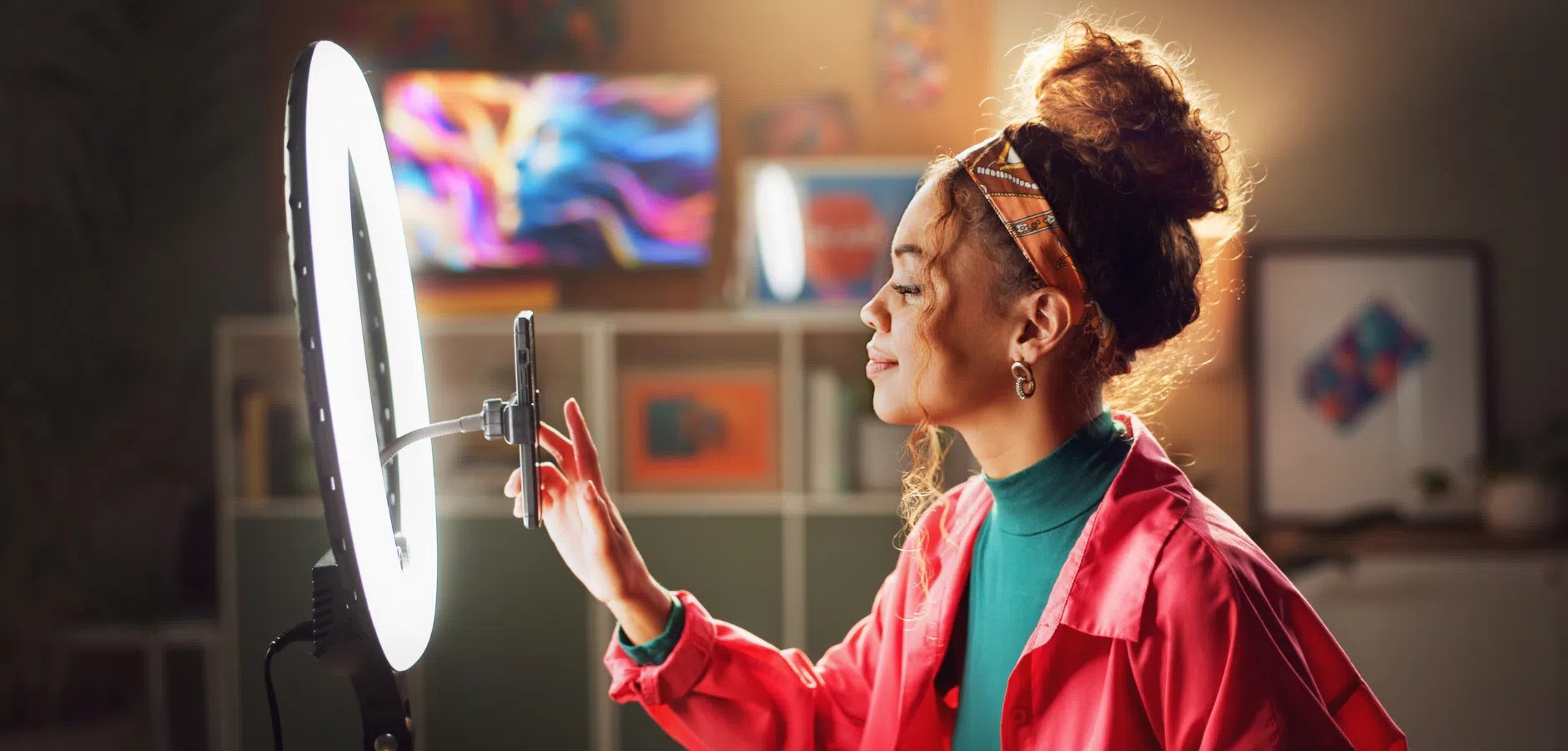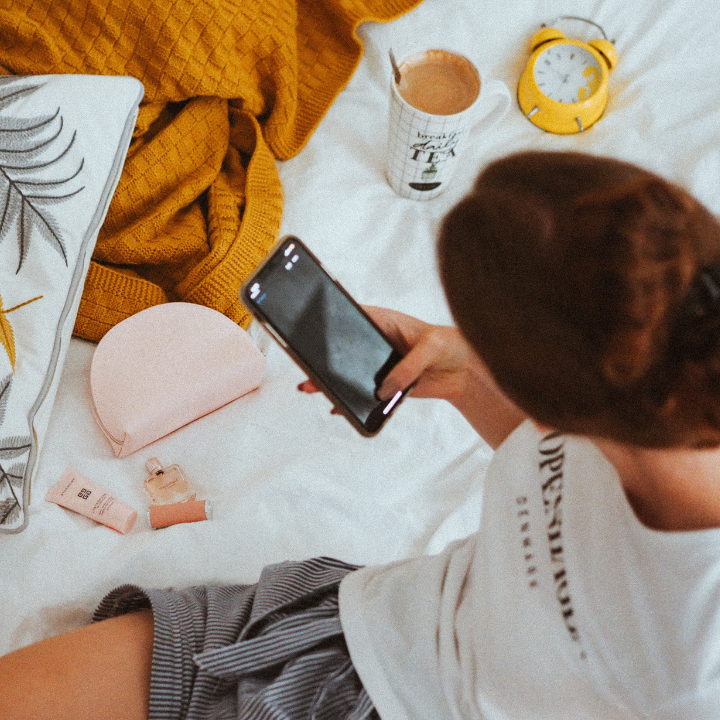You’ve created an amazing post, and the likes are rolling in. The brand is thrilled. Then comes the question, “Can we use this Reel on our website?”
Suddenly, you’re wondering how much you should charge for that.
Usage rights can be a goldmine for influencers if you know how to price them correctly. Knowing how long a brand can use your content and where they’ll share it puts you in control and guarantees you receive fair payment for what your content is worth.
To help you figure it out, we talked with impact.com’s Jade Rice, Creator Solutions Manager, and Natalie Van Dijk, Senior Manager of Media Services.
Develop the skills to calculate and negotiate usage rights that deliver your content’s full market value.
Table of contents:
- What are influencer usage rights and why do they matter?
- 5 key factors that determine usage rights pricing
- Usage rights rate benchmarks
- What to charge for influencer usage rights: Creating a pricing model in 6 steps
- Usage rights negotiation strategies to help you learn more
What are influencer usage rights and why do they matter?
Usage rights define how, where, and how long a brand can use your content after publishing it.
When you post organically on your profile, you control your content. You decide how long it stays up and where it’s seen. But if a brand wants to repurpose your content elsewhere—for example, turning your Reel into a paid ad—that’s when usage rights come into play.
Permission to share your work should come at a price. Understanding usage rights establishes fair compensation and creates clear boundaries that prevent brands from exploiting your content beyond agreed-upon terms.
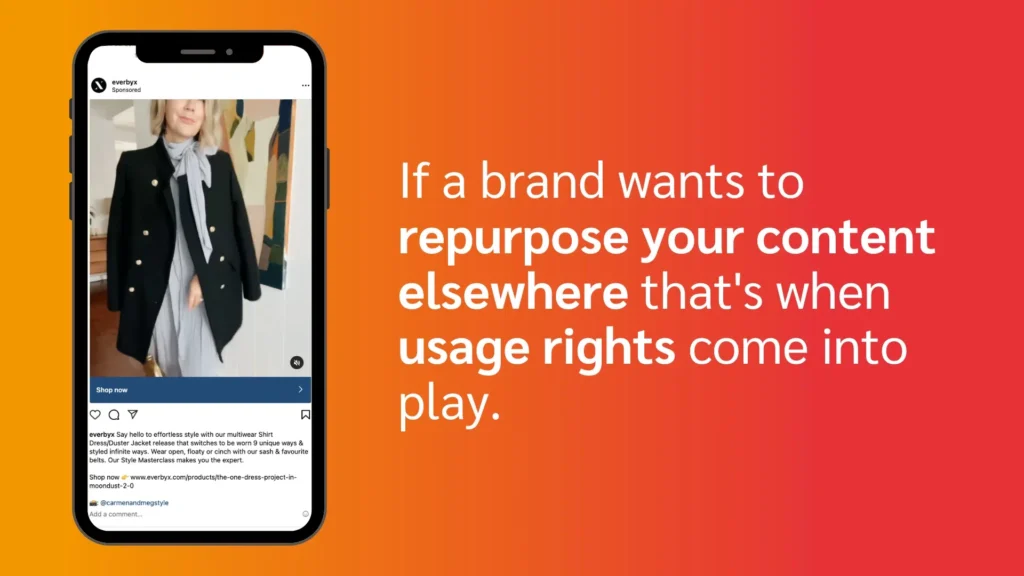
In this example, the clothing brand ever by X uses @carmenandmegstyle’s Reel as an engaging Instagram ad.
3 common types of usage rights
Brands and creators will usually choose between three categories of usage rights:
- Limited usage: A brand uses your content on one platform (e.g., Instagram) for a set timeframe (e.g., one month). After that, they must pay more or stop using it.
- Unlimited usage: Your brand partner can amplify your content across multiple platforms for a set period. Broader usage equals higher fees.
- Usage in perpetuity: The brand can use your content forever. If a brand requests perpetual rights, charge a premium—you’re giving away permanent control of your work.
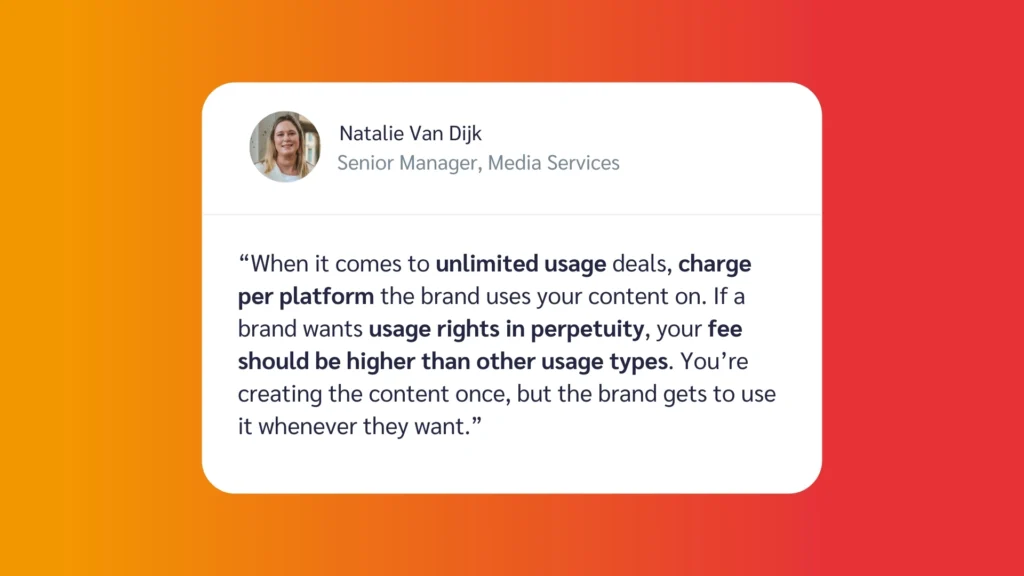
Content boosting vs usage rights
Content boosting–also called allowlisting—and usage rights are often conflated, but they serve different purposes.
Content boosting is when a brand pays to amplify an existing post on your profile, increasing its visibility. You still own the content—the brand simply pushes it to a larger audience.
For example, you might create a Reel about a skincare company’s new moisturizer and the brand pays to boost it for two weeks. You retain ownership, and the content stays on your profile.
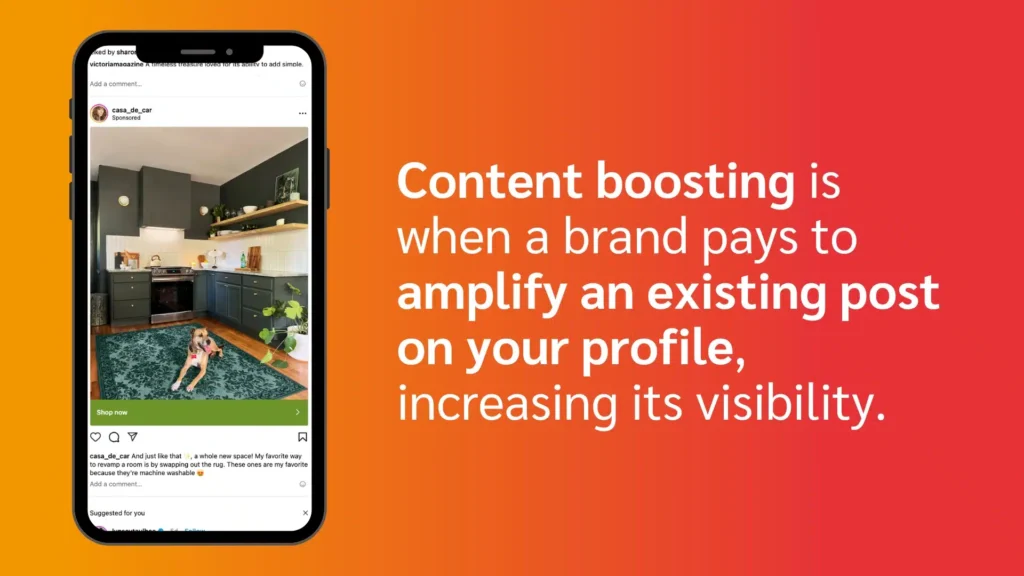
In this instance, Ruggable boosted Carla Morrone’s post showcasing her kitchen makeover with one of their rugs.
Usage rights allow a brand to repurpose your content on their platforms—giving them control over where and how your content appears. Sometimes this is also called paid user-generated content.
In this example, the skincare brand wants to use your Reel in a three-month email campaign. You’d negotiate usage rights and charge accordingly.
Keep in mind that even if you include usage rights in your contract, the brand should always let you know exactly where they want to reuse the content.
5 key factors that determine usage rights pricing
Usage rights pricing isn’t one-size-fits-all. How much you charge depends on these five key factors:
- Length of usage. The longer a brand wants to use your content, the more you should charge. Monthly usage is standard, but long-term or perpetual rights should increase your rate.
- Content type. Seasonal content—like holiday posts—typically has a shorter shelf life, while evergreen content holds value longer and justifies higher rates.
- Audience size and engagement. High engagement rates often make your content more valuable than your follower count, which means you can charge more.
- Content distribution channels. Social media content usually costs less than content used for paid ads, emails, or a brand’s website. Broader distribution means more exposure and higher pricing.
- Exclusivity agreements. If a brand asks you not to work with competitors for a certain period, charge more to compensate for lost opportunities.
Usage rights rate benchmarks
Most influencers set usage rights rates as a percentage of their base content fee.
Usage rights rates can vary widely depending on factors such as audience size, engagement, and how long the brand wants to use your content.
While every deal is different, here’s a general idea of how much to charge for usage rights: These are just average ranges—every influencer has their own unique pricing.
| Influencer tier | Monthly usage rights fees |
| Nano (<15k followers) | 0-50% |
| Micro (15k-75k followers) | 25-75% |
| Mid-tier (75k-250k) | 40-100% |
| Macro (250k–1m followers) | 50-125% |
| Celebrity (1m+ followers) | 100% and up |
What to charge for influencer usage rights: Creating a pricing model in 6 steps
Figuring out how much to charge for usage rights can be tricky, but it doesn’t have to be.
Here’s a simple, step-by-step framework to help you confidently price your content and earn what you deserve. Every influencer prices differently, so use these steps as a guide and adapt them to your unique situation.
Step 1. Start with your fee for the campaign deliverables
First, establish your baseline fee for the content itself.
If you’re not sure what to charge, benchmark your rates against other creators with similar follower counts and engagement levels. An influencer rate card can help give you a starting point (for your reference, not necessarily to share with the brand).
Having a clear baseline helps you negotiate effectively so you don’t leave money on the table. “Don’t hyperinflate or undersell yourself. You need to be familiar with how your posts and sponsorships perform,” he says.
Step 2. Calculate your base rate for usage rights
Most influencers charge an additional 20 to 50 percent of their base rate for usage rights.
Your follower count and engagement rate play a big role in determining your pricing. Higher engagement means higher value.
If possible, compare your rate with other influencers in your niche. You can find insights through peer groups and online forums, such as Reddit.
Step 3. Consider how long the brand will use your content
The longer the brand wants to use your content, the more you can charge. “We normally suggest that brands include one month of content usage in their contracts. But some brands want 12 months or even perpetuity, which makes it much more expensive,” Van Dijk says.
Rice points out that shorter usage periods work better for seasonal or timely content since it can lose relevance over time. “If it’s seasonal content or for paid ads, brands usually negotiate shorter usage terms—around 30 days,” he says.
Timely content may justify higher short-term rates, while evergreen content can be priced higher for longer-term use.
Rice also suggests focusing on seasonal rather than date or holiday-specific content to maximize value over time. Broader seasonal content can stay relevant for months, giving brands more flexibility and making it easier for you to justify higher fees.
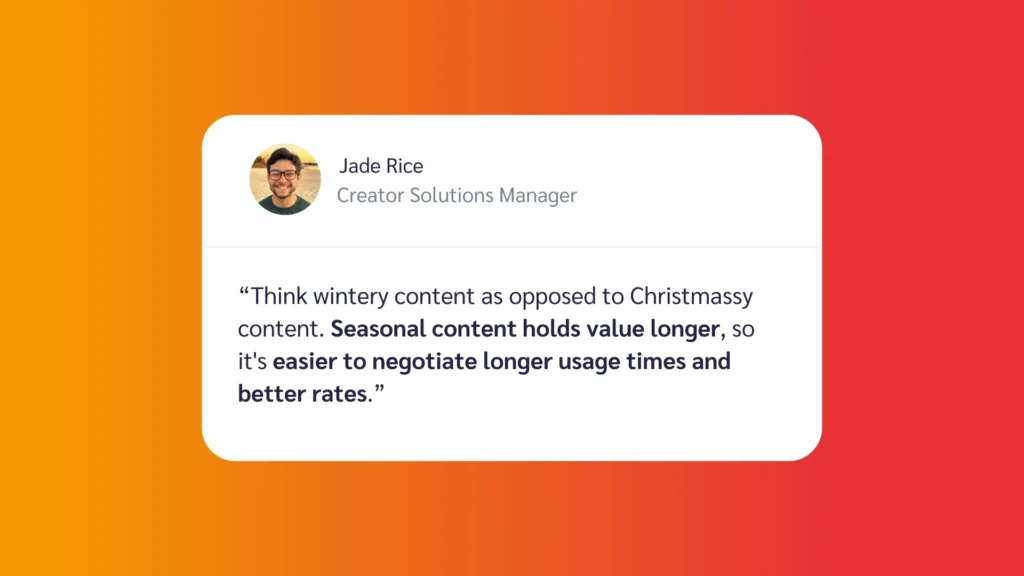
Step 4: Check which distribution channels the brand will use
Where and how a brand plans to use your content directly affects pricing. Posting to social media is one thing, but if the brand wants to use your content in emails, paid ads, or on their website, your rates should reflect the increased reach and impact.
Van Dijk explains that if a brand wants long-term, multi-platform usage, you’re giving them more value, and your pricing should reflect that added benefit. “More channels means more reach and a higher price,” she says.
Some brands may prefer to have multichannel usage rights by default—just in case they want to use the content in the future.
“One brand we work with always wants 12-month usage across their newsletter and YouTube channel. They’re not necessarily going to use the content right away, but they want to have the option to use it anytime within that window,” says Van Dijk.
Step 5. Determine if the brand wants you to boost the content
Boosting (or allowlisting) lets the brand pay to push your content to a larger audience from your account.
“Boosted content tends to perform better than taking a piece of content and making it an ad on the brand’s account. That’s why brands want to do it. It tends to feel more organic and authentic,” says Van Dijk.
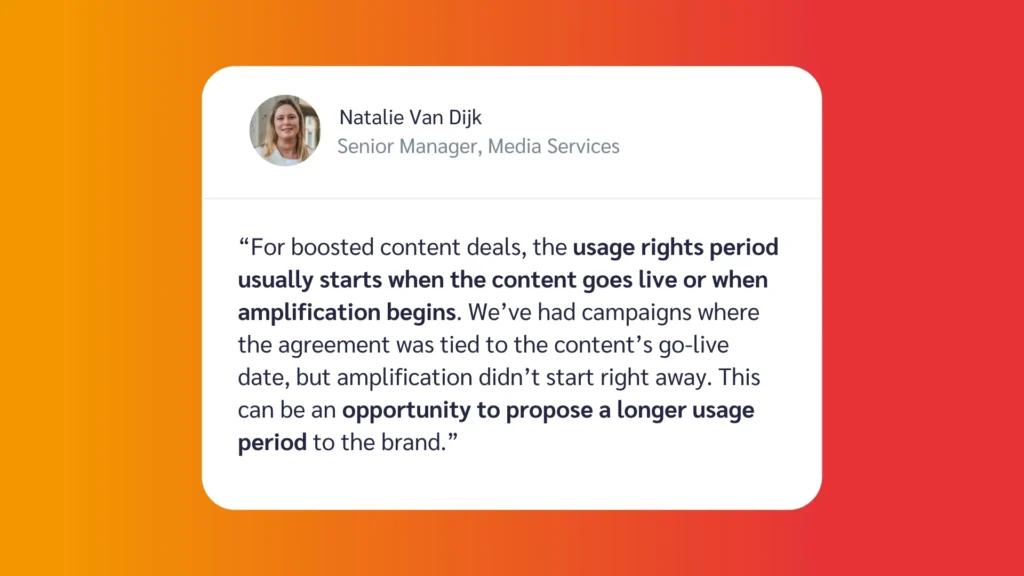
Creators typically charge five to 20 percent of the brand’s total paid ad spend used to promote the content.
Step 6. Tack on an additional fee for exclusivity clauses
Exclusivity means you can’t work with the brand’s competitors for a set period, which could limit your income from other deals.
“If you’re asked not to work with Macy’s or Target for two days before and five days after your post—that’s lost income. You have to build that into your rate,” says Van Dijk.
Most creators charge between 20 and 100 percent of their base rate, depending on the length of exclusivity and the brand’s size.
Step 7. Putting it all together
Here’s how it could look if a brand wants to use your Instagram post for three months, boost it, feature it on their website, and have a three-month exclusivity period:
Usage rights negotiation strategies to help you earn more
Smart usage rights negotiation means creating a deal that benefits both you and the brand. By taking a strategic approach to the conversation, you can lock in better terms and higher pay—while keeping the relationship solid.
Here’s how to negotiate confidently and maximize your earnings:
1. Ask about the brand’s budget
One common mistake influencers make is quoting their price too soon. Instead, ask about the brand’s budget first to avoid underselling yourself.
As Rice advises, “The first thing you want to do in a negotiation is ask about the brand’s budget. If you put out a number that’s too low, they might accept it right away—which means you’ve left money on the table.”

2. Back up your pricing with analytics
Brands want results, so lead with data when negotiating. Your engagement rates, conversions, and past campaign performance can justify higher rates.
Rice emphasizes that it’s important to be familiar with your analytics and understand how much you can realistically charge before negotiating. “If you have 100,000 followers with only one percent engagement, you can’t charge as much as someone with five percent,” he says.
If you’ve worked with the brand in the past, Van Dijk adds that you shouldn’t hesitate to request past campaign reports to strengthen your case.
“You can ask a brand for a report on your content’s performance. If your content drives sales or strong engagement, use that as leverage,” she says.
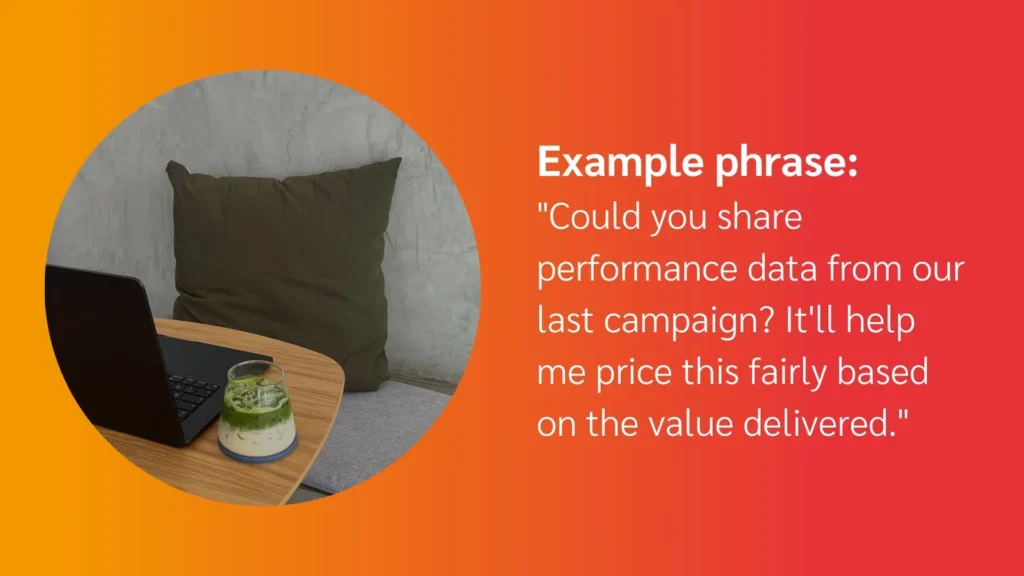
3. Negotiate usage duration and exclusivity clauses
If the brand wants to use your content for an extended period or prevents you from working with competitors, the more you should charge.
Rice suggests negotiating shorter terms initially, then adjusting based on content performance.
“We typically negotiate for 30 days upfront. If the content performs well, you can revisit and extend the agreement,” he says.
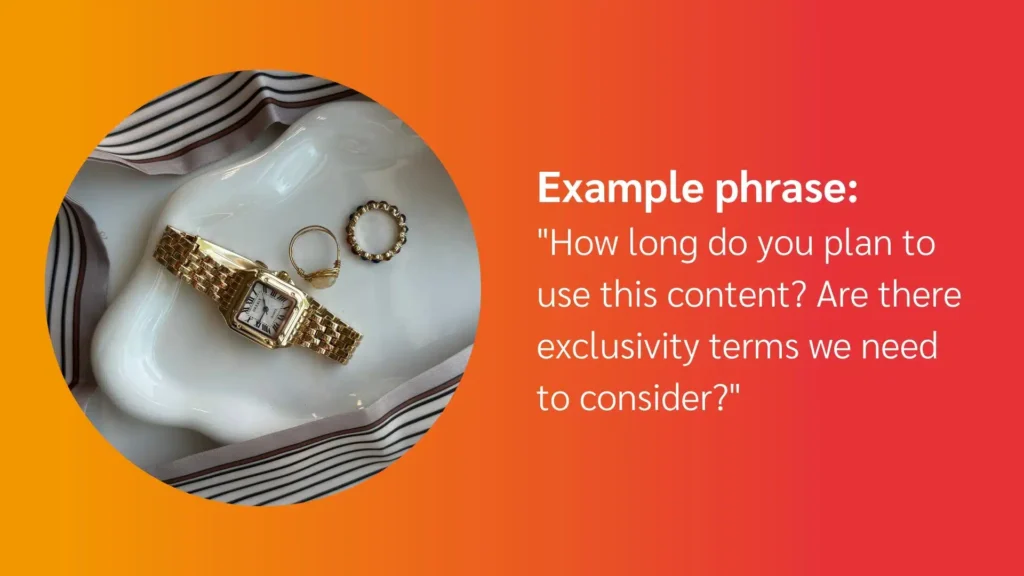
4. Raise your rates during peak shopping times
Demand for influencer content skyrockets during key shopping periods like Black Friday, holiday sales, or back-to-school season.
“Content drives sales during peak seasons, so that’s usually when you can negotiate better rates. Brands expect to pay more when competition for content heats up,” says Van Dijk.
Holiday-themed posts also have shorter turnaround times, making higher pricing easier to justify.
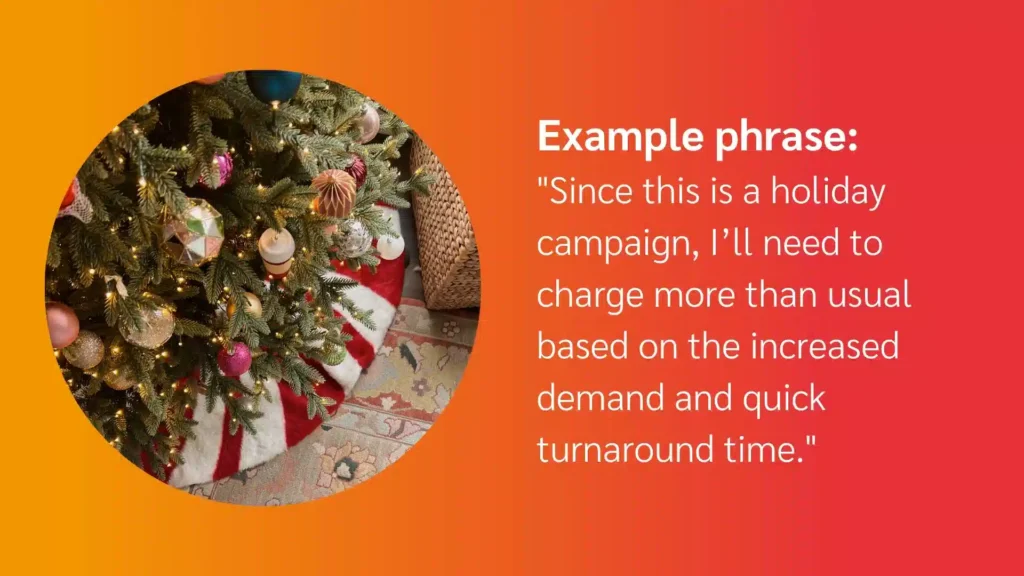
5. Keep your agreements flexible
Instead of immediately agreeing to long-term usage rights, build flexibility into your brand deals. Start short-term, then re-negotiate based on how the content performs.
Van Dijk recommends using performance benchmarks to help you secure better rates.
“If the content hits certain engagement or view rate thresholds, for example, a 100 percent or 80 percent view rate, that’s your leverage to charge more for extended usage,” she says.
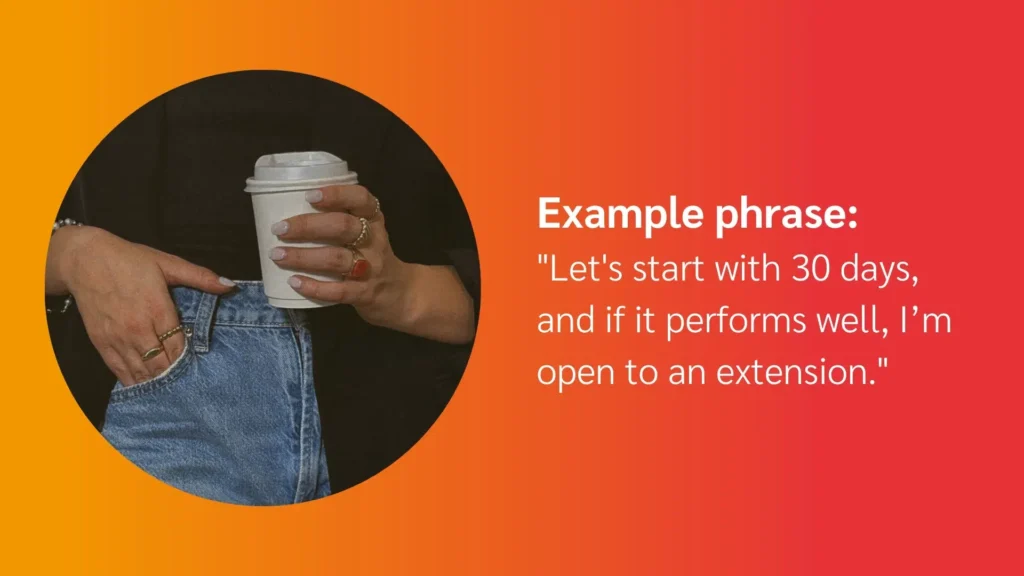
6. Align your strategy with the brand’s goals
The best negotiations happen when you understand the brand’s goals and position yourself as the solution.
Van Dijk explains that the more you connect your pricing to the outcomes brands want, the easier it is to justify higher rates. “If you know what the brand wants to achieve, you can tailor your offer to match those goals. That makes you more valuable,” she says.
Focusing on data, understanding brand objectives, and positioning yourself as a trusted partner will help you secure better rates and build lasting relationships.
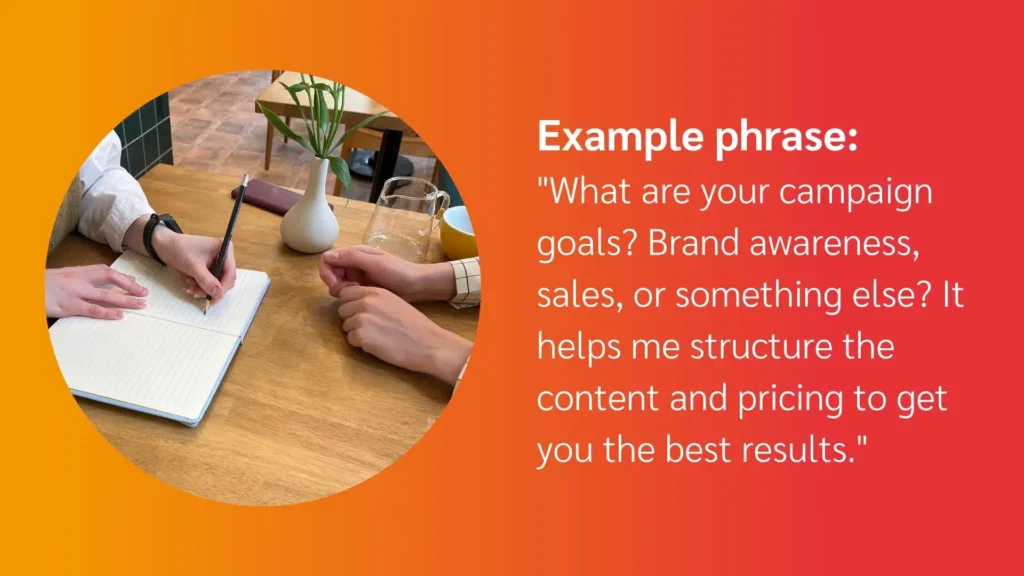
Secure top-tier brand collabs with smart usage rights pricing
Understanding usage rights is key to getting paid fairly as a creator. By clearly defining how brands can use your content, you’re protecting your value and setting yourself up for better deals.
Remember these essentials as you head into your next negotiation:
- Always start with your base rate and build pricing from there
- Back up your value with data, such as engagement rates and past performance
- Stay flexible and renegotiate terms as your content proves successful
- Align your offer with brand goals to position yourself as a valuable partner
Treat these negotiations as opportunities to advocate for yourself and create successful long-term partnerships.
Keep learning with these additional resources:
- Affiliate link disclosures: A creator’s compliance guide for 2025 (+ examples) (blog)
- Brand contracts decoded: 7 essentials every content creator should know (blog)
- Creating an influencer media kit in 5 simple steps [+ free template] (blog)
FAQs
Influencer usage rights define how, where, and how long a brand can use your content. For example, a brand might want to run your video in ads or feature your photo on their website. Negotiating usage rights secures fair compensation when brands use your content beyond your channels.
Usage rights in perpetuity mean a brand can use your content forever, with no time limit. You should charge a significantly higher rate because you’re giving permanent permission for them to reuse or repurpose your work
A typical starting point for paid usage is charging an extra 20 percent to 50 percent of your original content fee. The exact amount depends on factors like your audience size, engagement rates, how long the brand wants to use your content, and where they will share it. Longer usage periods or broader reach typically mean higher fees
Exclusivity rights mean you agree not to work with a brand’s competitors for a set period. You can charge more because this limits your opportunities to earn from other brands. The stricter or longer the exclusivity period, the higher your fee should be.
If a brand uses your content without proper usage rights, they’re violating your agreement. You can reach out and politely request they remove the content or negotiate a fair fee for continued use. Always clearly outline usage rights and pricing in your contract to avoid this situation.
